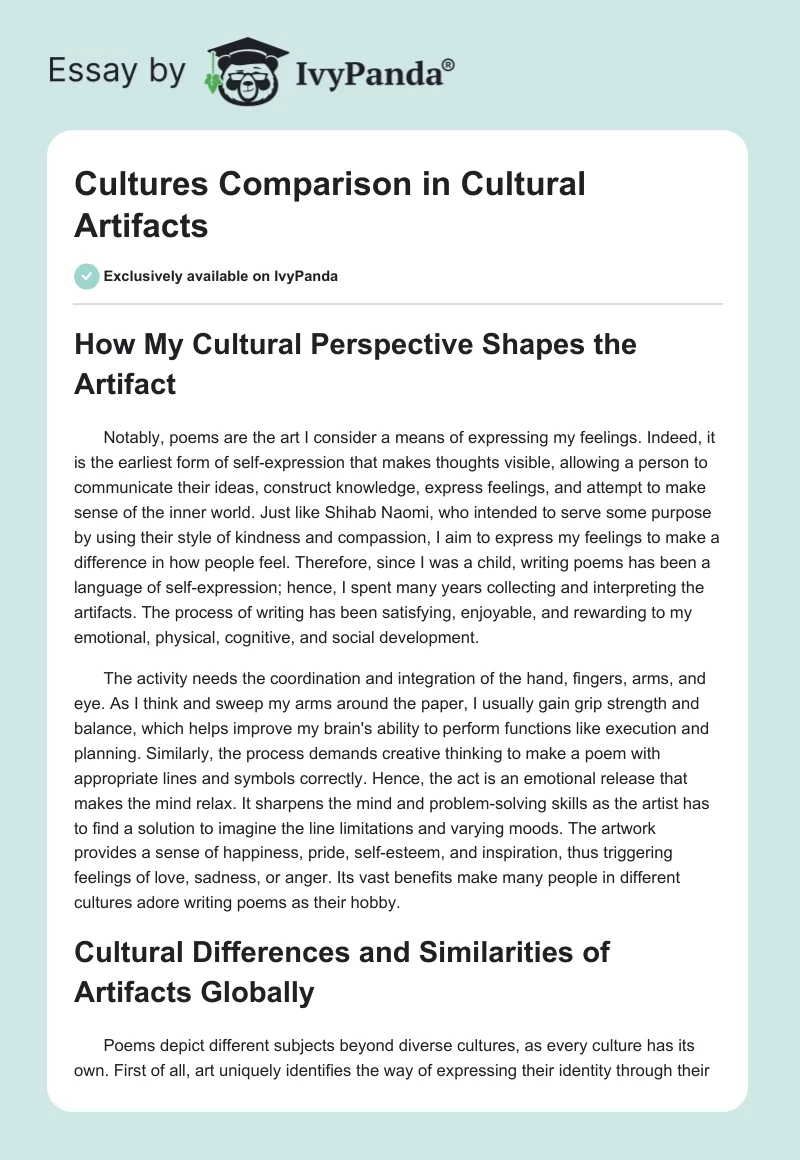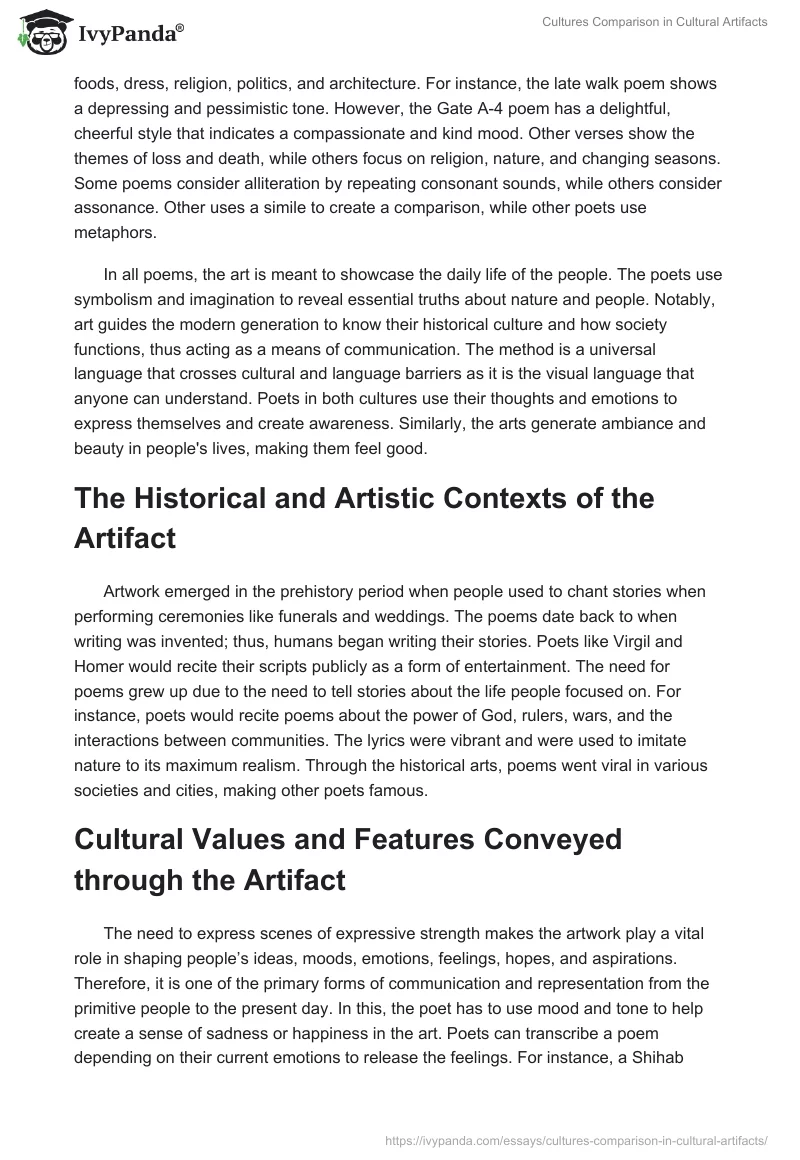How My Cultural Perspective Shapes the Artifact
Notably, poems are the art I consider a means of expressing my feelings. Indeed, it is the earliest form of self-expression that makes thoughts visible, allowing a person to communicate their ideas, construct knowledge, express feelings, and attempt to make sense of the inner world. Just like Shihab Naomi, who intended to serve some purpose by using their style of kindness and compassion, I aim to express my feelings to make a difference in how people feel. Therefore, since I was a child, writing poems has been a language of self-expression; hence, I spent many years collecting and interpreting the artifacts. The process of writing has been satisfying, enjoyable, and rewarding to my emotional, physical, cognitive, and social development.
The activity needs the coordination and integration of the hand, fingers, arms, and eye. As I think and sweep my arms around the paper, I usually gain grip strength and balance, which helps improve my brain’s ability to perform functions like execution and planning. Similarly, the process demands creative thinking to make a poem with appropriate lines and symbols correctly. Hence, the act is an emotional release that makes the mind relax. It sharpens the mind and problem-solving skills as the artist has to find a solution to imagine the line limitations and varying moods. The artwork provides a sense of happiness, pride, self-esteem, and inspiration, thus triggering feelings of love, sadness, or anger. Its vast benefits make many people in different cultures adore writing poems as their hobby.
Cultural Differences and Similarities of Artifacts Globally
Poems depict different subjects beyond diverse cultures, as every culture has its own. First of all, art uniquely identifies the way of expressing their identity through their foods, dress, religion, politics, and architecture. For instance, the late walk poem shows a depressing and pessimistic tone. However, the Gate A-4 poem has a delightful, cheerful style that indicates a compassionate and kind mood. Other verses show the themes of loss and death, while others focus on religion, nature, and changing seasons. Some poems consider alliteration by repeating consonant sounds, while others consider assonance. Other uses a simile to create a comparison, while other poets use metaphors.
In all poems, the art is meant to showcase the daily life of the people. The poets use symbolism and imagination to reveal essential truths about nature and people. Notably, art guides the modern generation to know their historical culture and how society functions, thus acting as a means of communication. The method is a universal language that crosses cultural and language barriers as it is the visual language that anyone can understand. Poets in both cultures use their thoughts and emotions to express themselves and create awareness. Similarly, the arts generate ambiance and beauty in people’s lives, making them feel good.
The Historical and Artistic Contexts of the Artifact
Artwork emerged in the prehistory period when people used to chant stories when performing ceremonies like funerals and weddings. The poems date back to when writing was invented; thus, humans began writing their stories. Poets like Virgil and Homer would recite their scripts publicly as a form of entertainment. The need for poems grew up due to the need to tell stories about the life people focused on. For instance, poets would recite poems about the power of God, rulers, wars, and the interactions between communities. The lyrics were vibrant and were used to imitate nature to its maximum realism. Through the historical arts, poems went viral in various societies and cities, making other poets famous.
Cultural Values and Features Conveyed through the Artifact
The need to express scenes of expressive strength makes the artwork play a vital role in shaping people’s ideas, moods, emotions, feelings, hopes, and aspirations. Therefore, it is one of the primary forms of communication and representation from the primitive people to the present day. In this, the poet has to use mood and tone to help create a sense of sadness or happiness in the art. Poets can transcribe a poem depending on their current emotions to release the feelings. For instance, a Shihab Naomi poem uses a tone of compassion and kindness to relieve people of their distress and worries (Almarhabi, 2020). They use different lines to express what they feel. Indeed, they use a choice of words to indicate if they are frustrated, contemplative, or anxious. Other painters use words to show their confusion, thus making the poem sorrowful.
Similarly, the painters use art to indicate their happiness. Personification is used to indicate the happy feeling of love. For instance, the poem by Naomi shows laughter and contentment to tell their sorrowful moments have been replaced with the poet’s compassion and kindness. Other parts in the poem, like crying and sobbing, show sadness, mystery, and disgust.
By reading and writing using imaginative lines, my mind relaxes, and after completing the art, I relieve my mental strain. The process requires skillful concentration on every step needed. Hence, the mind forgets the disturbing aspects as one is forced to concentrate on the present moment. After creating a beautiful poem, I start feeling like I am creative, thus making myself happier and improving my mental health. I prefer people who feel stressed or happy to consider writing as an activity to pour out any emotions, thus cultivating emotional growth.
Reference
Almarhabi, M. (2020). Cultural trauma and the formation of Palestinian national identity in Palestinian-American writing [Doctoral dissertation, Kent State University].


